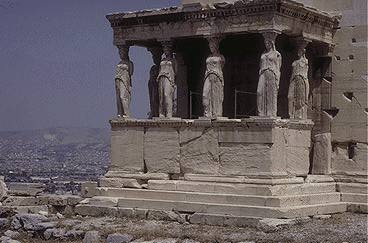
[Image] The Erechtheion
The Peloponnesian War erupted as soon as the Parthenon and the Propylaia were completed. Not long after this, Perikles died in the epidemic which had raged in Athens. Yet the Athenians did not abandon his plans. With the temporary cessation of hostilities brought about by the peace of Nikias in 421 B.C., work began on the temple of Athena Polias, subsequently known as the Erechtheion. The architect who designed the building is unknown, but one finds it difficult not to recall Mnesikles when gazing upon this remarkably graceful lonic structure, unique in Greek architecture for its originality of conception and its functional adaptation to accommodate the needs of so many cults. Who but Mnesikles could have given such a daring and original solution to the most difficult problems of an irregular terrain and especially the multiple religious needs of the numerous cults.
For the structure would primarily provide for the worship of Athena Polias and at the same time that of Poseidon. Moreover, the sanctuary would hold the graves of Erechtheus with the sacred snake, and of Kekrops, the ancestors of the Athenians, as well as the signs from Poseidon's trident ancestors of the Athenians, as well as the signs from Poseidon's trident which produced water, the "Erechtheis Sea," a well that contained [Image] salt water, and the marks from the thunderbolt of Zeus. The altars of Zeus Hypatos, of Peseidon and Erechtheus, of Hephaistos, of the hero Boutes, of the Thyechoos, and the very ancient xoanon of Hermes, all had to be accommodated harmoniously. Lastly room would have to be found for the sacred olive and the sanctuary of Pandrosos which included the altar of Zeus Herkeios. The architect succeeded by subtle and ingenious use of the differences in level to produce an astonishing temple which satisfied the requirements of all these cults. He respected the traditions and at the same time introduced striking innovations.
The resulting building may appear complicated at first sight, but it bears the mark of true genius and contains more original feature than any other structure in the Greek world. It consists of three almost independent sections (the main temple, the north extension and the porch of the Karyatides) with three separate roofs, and is built at four different levels. Ionic columns of three different dimensions and proportions are used, and, following an old Ionian custom, use is also made of Korai as supports for the entablature - the famous Karyatides. The temple is divided into two main parts, the east devoted to Athena Polias and the west to Poseidon-Erechtheus. The Erechtheion is the finest expression of the Ionic order, yet the building loses none of the compact austerity of classical Attic architecture. The frieze was of Eleusinian stone of a deep grey colour, and relief figures were attached to it and secured by means of metal connecting pins set in the slabs. Finally, there was a famous gold lamp inside it, made by Kallimakhos, the artist who is traditionally credited with the invention of the Corinthian capital.
[Image] Back to the WebAcropol Guided Tour Page
1995 Andreas B. Syrigos. E-mail address : asyrigos@theseas.ntua.gr